
Pavel Tsatsouline - Bullet Proof Abs (2nd Ed)
.pdf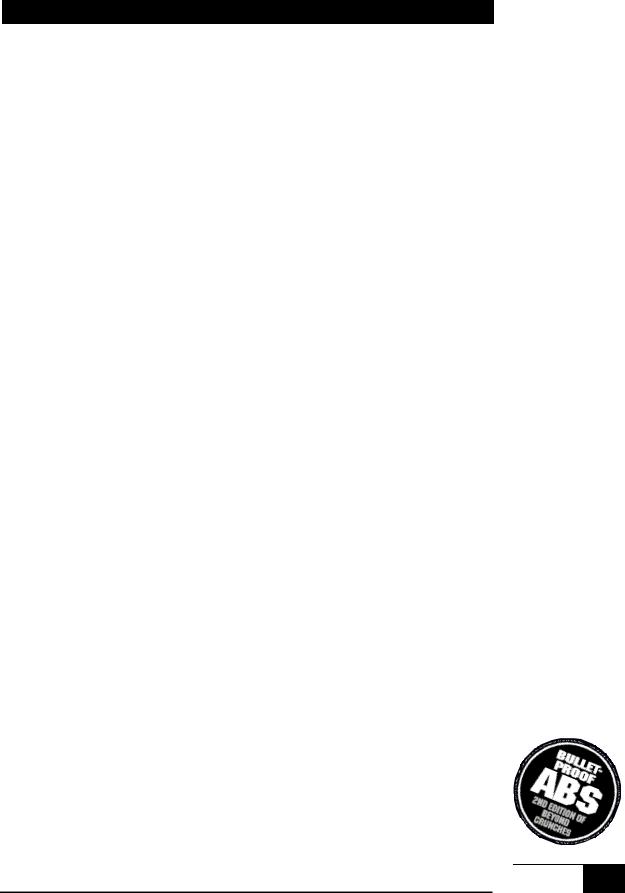
QUESTIONS AND ANSWERS
Part V
Questions & Answers
Q: Everybody knows that abs should be 'burned' with high reps and a very light weight. You recommend heavy low rep training. Don’t you get it that I don’t want to build my abs?! I just want to tone them!
Chill out, Ma’am. 'Everybody' should not have slept through their Physiology 101. The 'burn' you feel from high reps is from lactic acid buildup and does absolutely nothing for toning up your muscles. Tone is residual tension in a relaxed muscle. The logical way to develop it is by tensing the muscle. High tension training is high resistance training.
High repetitions and high resistance are mutually exclusive. Voila!
Now, in order to understand why you will not build up your waist following my program, you have to understand how muscle is built—and then do the opposite.
In cybernetics, the science about control in different, including biological, systems, there is a concept of the black box. A VCR is a black box. You do not know what is inside, yet you get what you want. Pop a tape into the VCR, switch your TV to Channel 3, and the Star Wars are back. Only the cause and effect matter.
Nobody knows what happens inside a muscle when it grows bigger. However, we know what buttons to push to get the hypertrophic response. These buttons are tension and fatigue.
Tension is a function of the load—the heavier the weight or the more challenging the exercise, the higher is the tension. At a first glance it makes sense to train with maximal weights.
However, a weight that is too heavy cannot be lifted enough times to induce a high level of fatigue. A light weight lifted to failure will tire your muscles out but the tension will be pathetic. A Catch-22.
101
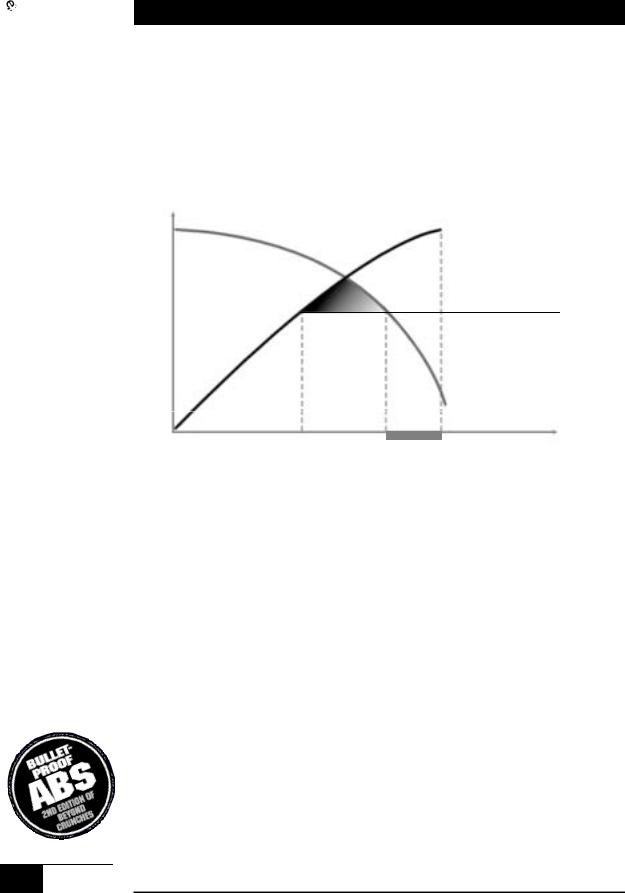
QUESTIONSABLE OF ANDCONTENTSANSWERS
To trigger muscle hypertrophy one has to reach a certain compromise of fatigue and tension, the fatigue/tension threshold. I am simplifying things somewhat, but a weight that you can lift for 30-60 seconds, or around 6-12 times before failure generates enough tension and fatigue to build muscle.








 F/T Threshold
F/T Threshold
|
|
Strength |
1RM—THE HEAVIEST |
Endurance |
Mass |
& Tone WEIGHT YOU CAN LIFT |
|
|
|||
|
12 Reps |
6 Reps |
WEIGHT |
|
or 60 sec |
or 30 sec |
|
Keep your sets under half a minute, or, even under twenty seconds, cut your reps to five and under. To avoid cumulative fatigue bump up the rest intervals between the sets to—gasp!—three to five minutes, and keep your set total to five and under. You can easily remember this as the '3-5 method': 3-5 sets, 3-5 reps, 3-5 minutes of rest between sets. Such a radical workout will only make you harder and stronger—not bigger.
As for the wimpy high rep stuff, it’s not only more than worthless, it can puff you up! Such training, or 'muscle spinning', was popular among California bodybuilders back in the fifties. They were big, weak, and soft.
102
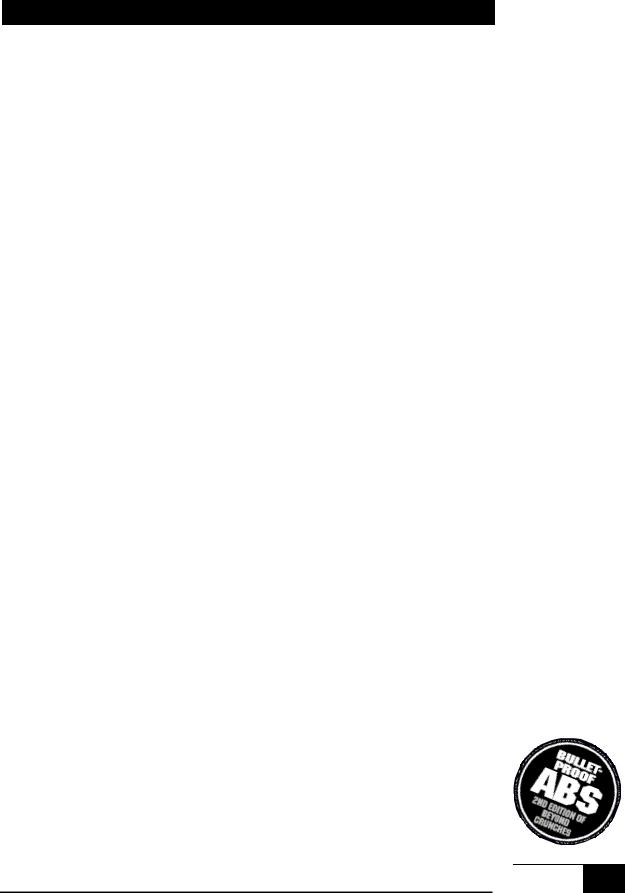
QUESTIONSABLE OF ANDCONTENTSANSWERS
High repetitions develop muscular endurance. In the case of the 15-50 rep range most 'shapers' and 'toners' use, it is anaerobic, or short term, endurance. In this mode your muscles burn glycogen, a form of sugar, for fuel. It is stored, among other places, in the muscles. High rep training depletes your glycogen reserves. To prevent such a critical situation in the future, your body will store more glycogen than before. Now here is the catch. Each molecule of this substance binds with three molecules of water. Jiggle, jiggle! You look like you could cross the Sahara desert without refueling!
Q: I heard that a muscle should be 'confused' by changing my workout constantly. How should I do it?
No matter how well designed your workout is, it is not going to work forever. The physiological Law of Accommodation states that an organism stops adapting to a training stimulus after a period of time, usually four to six weeks. Your body figures, "Hey, it hasn't killed me yet, why bother to adapt?" At this point a change in the program is called for. The change can be quantitative like increasing the number of sets or cycling the workload in a manner described in my book Power to the People!: Russian Strength Training Secrets for Every American, or qualitative, that is replacing the exercises.
The Bullet-Proof Abs approach to refreshing your workout is straightforward: pick one or two drills from this book, focus on them for a month or so, then switch to something else. It is a good idea to do Janda situps every other rotation.
Do not fall for 'muscle confusion' or changing your exercises every workout. Adaptation to constantly changing stimuli is impossible by definition. A shotgun mix of exercises confuses the organism by constantly changing demands instead of shocking it into specific adaptation. Overhauling your workout too often is just as bad as doing the same old thing for too long. It is OK though to vary your sets, reps, and rest intervals every session. Be careful to stay more or less within the 3-5 limits if you do not want to bulk up.
103
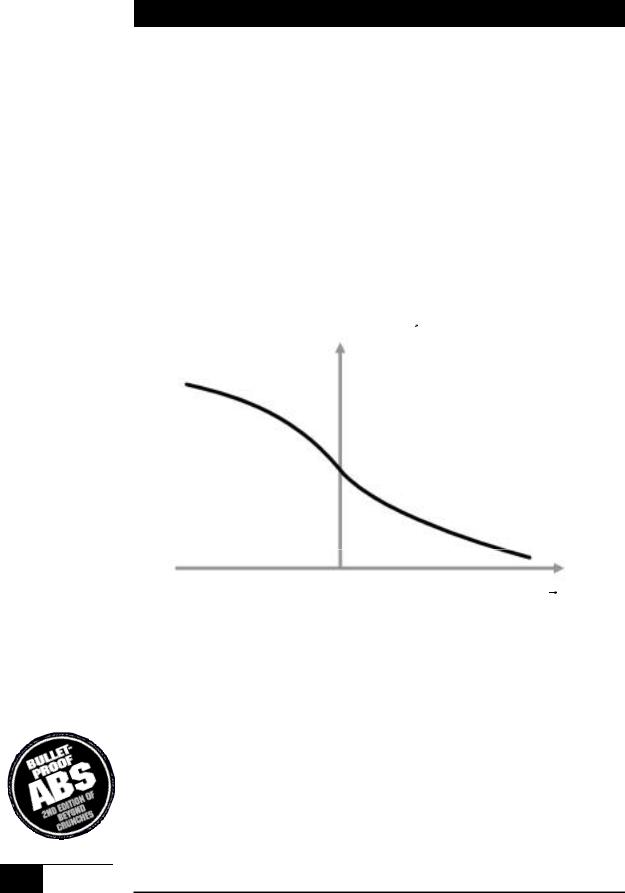
QUESTIONSABLE OF ANDCONTENTSANSWERS
Q: Are 'negatives' good for toning the abs?
Excellent!
'Negatives', or the lowering half of an exercise, generate up to 1.3 times more muscular tension than 'positives', or the lifting half.
Look at the force-velocity curve. There is an inverse relationship between the force of the contraction and its velocity. The slower the contraction, the higher is the force (tension). When the speed of contraction is negative, the tension is at its highest values.
FORCE (F )
Negative
(Lowering) Isometric
 (Holding)
(Holding)
Positive (Lifting)
– |
0 |
+ |
VELOCITY (v)
Research suggests that the optimal load for negative training is one that you can lower slowly and halt at will. Don't use a weight that is too heavy and makes you lose muscular tension and fall like a rock!
Not every exercise lends itself to negatives and some drills, e.g. the Saxon Side Bend, require spotters if you choose to employ this training modality.
Use your head.
104
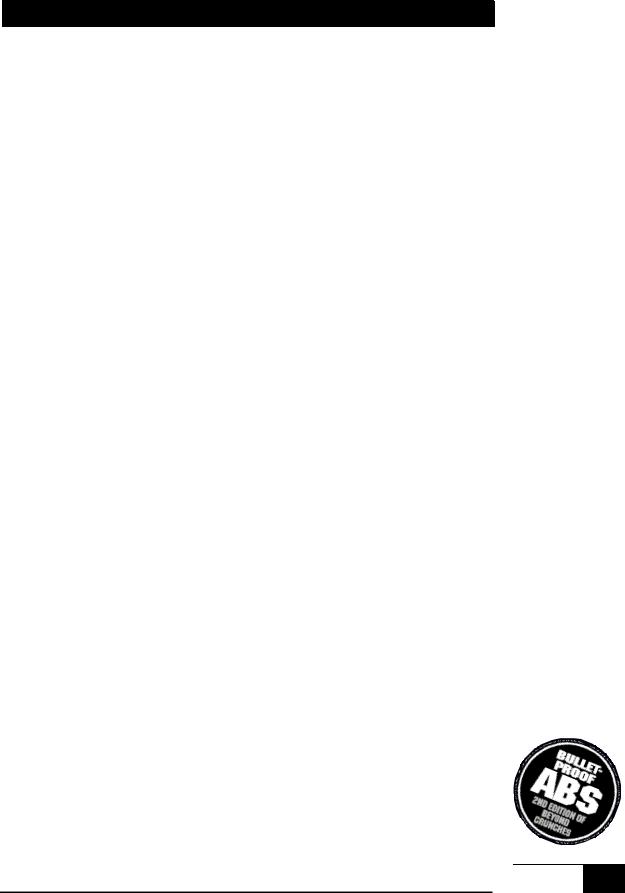
QUESTIONSABLE OF ANDCONTENTSANSWERS
Q: What about isometrics?
If you look at the force-velocity curve one more time, you will see that isometric training, or holding the weight, rather than lifting it, also induces more tension than lifting.
A very effective way of incorporating isometrics into your ab training regimen is the Soviet static-dynamic method. It requires you to pause for three seconds at different stages of an exercise, especially at the hardest spot. Do not hold your breath if you use this technique; breathe shallow while keeping your core tight.
Q: What do you think of super slow training for the abs?
The force-velocity curve says it works. The lower is the velocity, the higher is the tension. Super slow works. But, like everything else, it works best if you switch to something else after a while. A 1975 Russian study by S. I. Lelikov determined that a program which varied the exercise tempo over a period of time was roughly 150% more effective in developing strength than constant super slow training!
Q: Can I develop great definition in my abs with only one set of an exercise?
You might, but I would not bet on it.
105
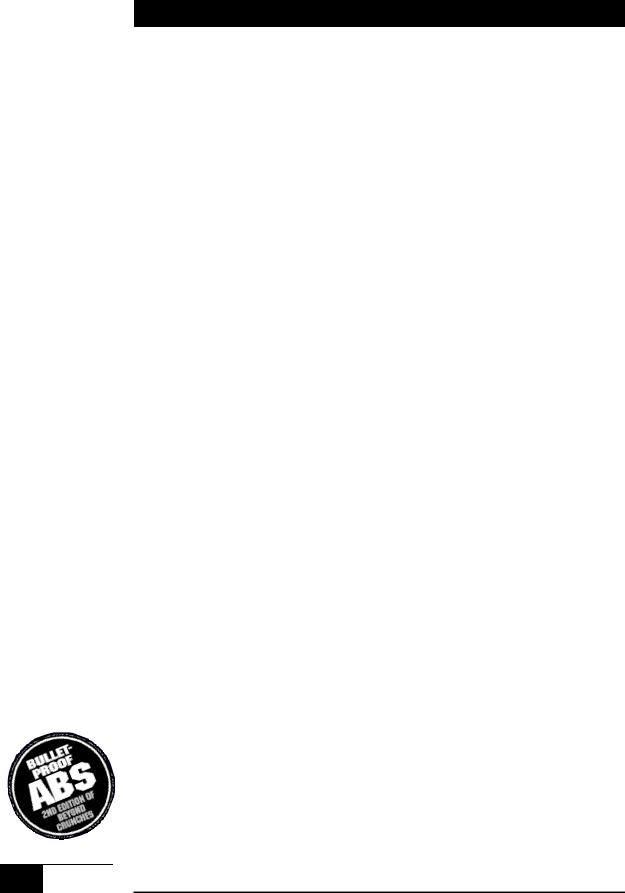
Q UESTIONSABLE OFANDCONTENTSANSWERS
Q: Is your low rep program going to give me a 'six-pack'?
The program was designed to strengthen and harden your abs. If you want a prominent six-pack, the abdominals have to be built to a degree. One way of doing it is to finish your heavy low rep workout with a lighter set of over 20 seconds in duration, or 6-12 reps to failure, assuming an average lifting tempo. You can do the same, or a different, exercise. For example:
1. |
Situps: |
3x5 @ 35 pounds |
2. |
Situps: |
1x12 @ 10 pounds |
________________________________________________________________
1. |
Scissor situps: |
4x4 @ 25 pounds |
2. |
Ab Pavelizer™ situps: |
1x10 @ bodyweight only |
Or you could simply do more sets, e.g. 10x5, and compress the rest intervals between them to 1-3 min.
Q: Can I train my abs every day?
Soviet research demonstrated that athletes who increase the number of their weekly workouts while keeping their training volume—or the total number of repetitions—constant, immediately show a significant strength increase. If you do 5x5 once a week, 1x5 five times a week will be more effective. My dad Vladimir Tsatsouline has recently worked up to seventeen consecutive pullups by doing this exercise every morning. He could not do that many at any point of his thirty-two-year service in the Soviet Army.
Yet I am not pushing for daily training or multiple daily workouts because it is not practical for most people. You can get great results training three times a week. If you choose to train more often, spread the sets you have been doing over more workouts. Later, when you can comfortably handle the load, you might want to add sets.
Another option is to pick an exercise you can do anywhere, for example the Russian ballet leg thrust or the jackknife pushup, and do a set of up to five reps here and there throughout the day. It is imperative that you try to avoid fatigue when following this method! Your last set of the day should feel almost as fresh as the first one.
106
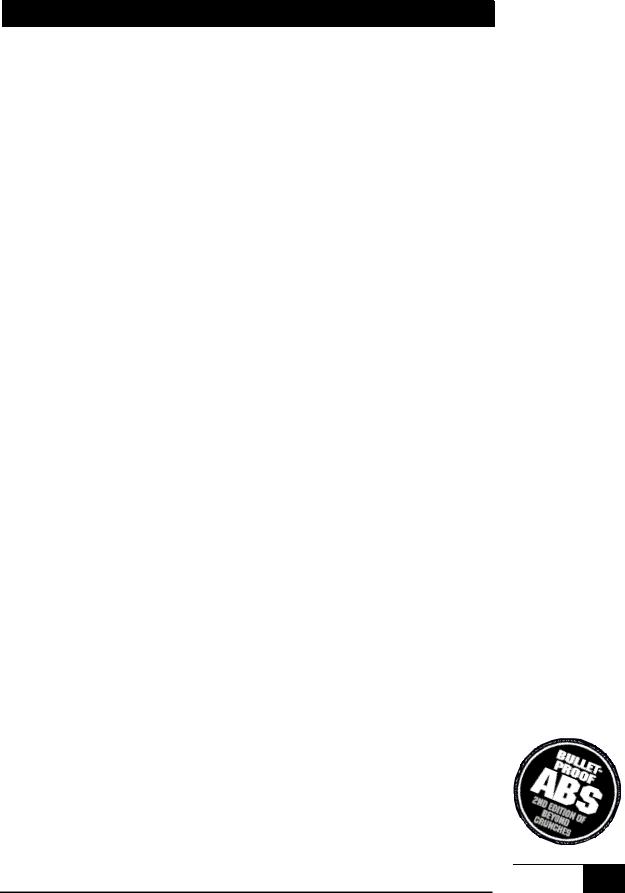
QUESTIONSABLE OFANDCONTENTSANSWERS
Q: I don't have health club membership and can't do the one arm deadlift and the full contact twist. Any suggestions?
Buy a 300 pound Olympic weight set. It sells in most sporting goods stores for around $150, including the bar.
Q: Can I do twists on a Nautilus machine instead of the full contact twist?
I wouldn't.
Unlike the abs, the obliques do not need to be isolated for maximal training effect. Remember the Law of Irradiation. A contraction of a muscle amplifies the contraction of the adjacent muscles. What was a liability in ab training is an asset in oblique training. The tension in the hips and abs will enable you to lift more weight and better overload you obliques.
Also, the full contact twist teaches athletes to integrate their hip, midsection, and upper body efforts into a lethal punch or other sport skill.
Q: Do I have to do separate exercises for my abs and my obliques?
If you wish. Either way you work the entire midsection, just with a different emphasis.
Q: Many muscle magazines recommend doing ab exercises before lifting weights. Do you think it is a good idea?
Definitely not. These muscles stabilize the spine under heavy loads, and preexhausting them could lead to back injuries later in your workout.
107
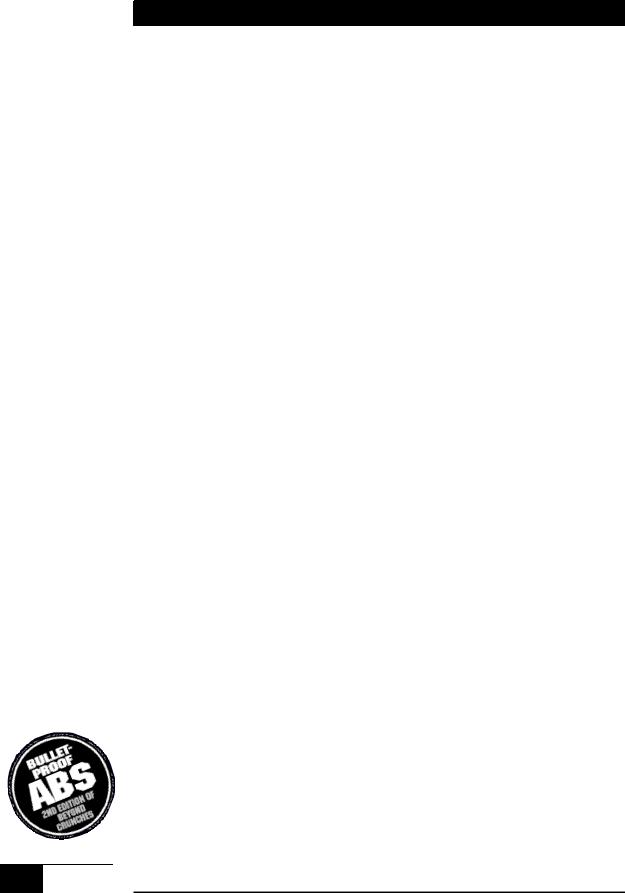
QUESTIONSABLE OFANDCONTENTSANSWERS
Q: What kind of warmup and stretching exercises do I need to do before training my abs?
None, with the rare exception of the back stretch described in the chapter about the Ab Pavelizer™.
I have explained in great detail why warming up is a waste of time in my stretching book. You can find the order information at the end of this volume.
If you have hyperlordosis, or an exaggerated arch in your lower back, you need to stretch your hip flexors. A couple of state of the art hip flexor stretches are covered in my new stretching book. Remember to clear the stretches with your doctor if you intend to do them to correct a medical condition.
Q: You are saying crunches do not work. It doesn't make any sense. My aerobic instructor swears this is all she does for her abs—and she looks fantastic!
Do you believe that Cindy Crawford looks like Cindy Crawford because of the exercises she demonstrates on her tapes, or because she was born Cindy Crawford?
Business heavyweight Robert Ringer once said that successful people often do not know what really got them to the top. Translation: you can rely on no authority but hard scientific facts and common sense.
Asking people with good abs about the secret of their success is similar to asking a person with a nice smile about dental care. Even if they are honest, they often attribute it to the wrong reasons.
There can be a number of explanations. An obvious one is your aerobic instructor picked the right parents. Another possible source of the lady's superior definition is some high tension activity she engages in, rock climbing or weight training, for instance.
108

QUESTIONSABLE OFANDCONTENTSANSWERS
Former Mr. Universe Mike Mentzer had awesome abs in his hey day, yet rarely trained them. His exceptional midriff was the result of heavy squats and deadlifts. Mentzer worked up to over 1,100 pounds in the quarter squat, and it is obvious that it took a tremendous amount of tension in the muscles of the core to stabilize his spine under such a load.
Q: My calves get sore and sometimes cramp when I work out on the Ab Pavelizer™. What can I do about it?
Strengthen your calves, drink plenty of water and make sure you get enough potassium in your diet. If they still cramp, you may have a health condition.
Q: In my taekwondo class the instructor has us drop medicine balls on each other's stomachs to condition us against kicks and punches. Is this kind of training safe? Is it effective?
No training method is 100% safe. If you do not flex your abs in time, you could conceivably damage your inner organs. It is no different from taking a punch. By the way, in the Soviet Special Forces boot camp drill instructors would hit us in the stomach and expect us to keep a straight face! As I learned later, when it was my turn to punch, it was done mostly for the DIs' amusement. Still, the troopers got desensitized against pain and developed the reflex of bracing up before the impact. While my lawyer would not let me pedal that kind of abuse, I will admit that medicine ball training offers similar benefits in a more controlled environment.
109
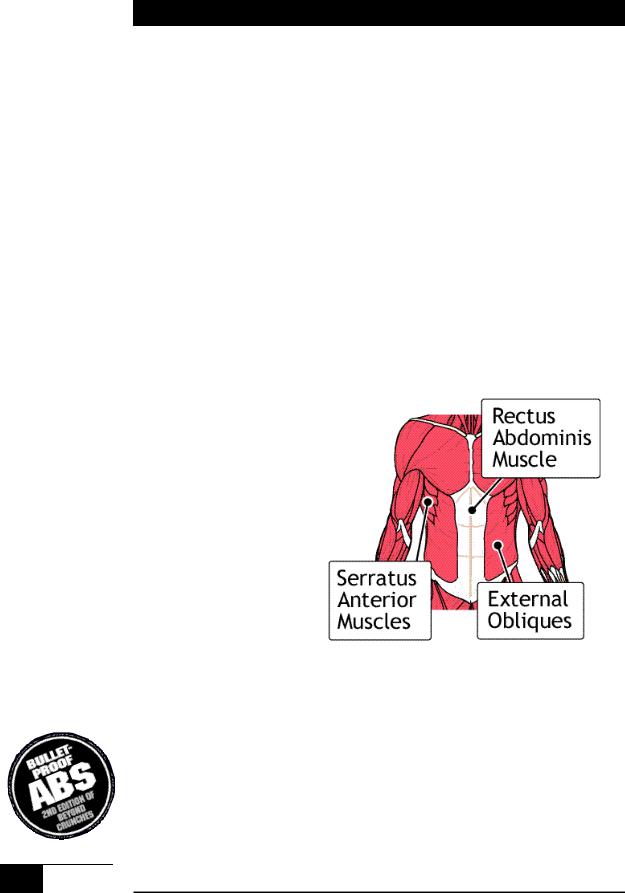
QUESTIONSABLE OFANDCONTENTSANSWERS
Q: My neck bothers me when I do my ab exercises.
Do you think I should buy an AbRoller?
No.
According to William Kraemer, Ph.D., the president of the National Strength and Conditioning Association, neck support provided by ab training machines creates an unhealthy strength imbalance between the abdominals and the neck muscles. So the neck support is not an asset, but a liability. You haul your head around all day, get used to it!
Anyway, your neck is not likely to tire if you follow the low rep method described in this book.
Q: I feel that most abdominal exercises work my upper abs only. What about my lower abs?
Please pick up any anatomy book. You will not find either 'lower abs' or 'upper abs'. Ther is only one long muscle, rectus abdominis, connecting your sternum and your pubic bone.
It is impossible to selectively develop a part of a single muscle because of the peculiar way your muscles are
hooked up to your brain. Each motor nerve controls its own group of muscle fibers called a motor unit. The constituent fibers are evenly spread out throughout the muscle, rather than being concentrated in its 'peak', or 'sweep', 'lower', or 'upper' part. Even if you manage to recruit a different motor unit with a different exercise, its fibers will still be all over the muscle. So no matter where you attach the load, to your torso, or your legs, you will train the entire length of the abdominal muscle.
110
